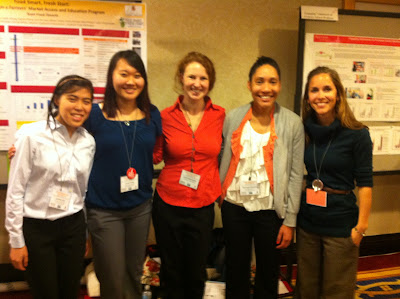By Monique Thornton,
Junior Community Health major
for the School of Public Health Student Ambassadors Program
Public health is my life, and I’ve known since the eighth
grade that it is my calling. When I was applying to colleges in high school, I
only applied to those that offered an undergraduate major related to public
health. Once I was here in Fall 2009, I knew right away that I was in the right
place.
One day during my freshman year, I had just gotten out of
class and was walking around SPH. I saw a sign posted for the Annual Research
Interaction Day. So I checked it out. I was walking the aisles of posters and speaking
with different professors and students about their research. And it was that
day that I met Dr.
Stephanie Grutzmacher, a faculty research associate and professor of Family
Science. Her research was on health literacy, a topic that I had been
interested in at the time. We began to talk, and by the end of over
conversation, she had offered me a research position on her undergraduate team.
That seemed odd to me at first, that she would want me, a
freshman helping her out with research. But that’s the thing about SPH.
Professors’ doors are always open, inviting you to come and talk to them. They
are warm and welcoming, and are happy to help students out with advice, coursework,
and research opportunities. Stephanie was and is no different. I worked with
her during my second semester of freshman year. It was then that I asked her to
become the research mentor of a project I had just planned within the Gemstone Program. I had become very
interested in food deserts, areas with no healthy food options within walking
distance, and wanted to use GIS to map them within Prince George’s County.
Though she was and still is the busiest person I know, she
accepted. With a mentor on board, I presented my research idea to my Gemstone
class, and they voted. Team Food
Deserts was born! Carolina Aguiar, Valerie Caplan, Emma Chang, Sophia
Chang, Jennifer Kuo, Moses Lahey, Rutvij Pandya, Kate Richard, Kelci Schexnayder,
Rachel White, and myself have been working on our research ever since. It’s
been two years since then, and we’ve gone through so much as a team.
 |
| Team Food Deserts freshman photo. Spring 2009 |
Not too long after our formation, we had a major setback. Students of Dr.
Jim Cohen, director of the Urban Studies and Planning Program here at UMD, published
a very comprehensive Community Planning Studio report on food deserts in Prince George’s County—GISmaps included. Since Gemstone has a rule that no team can do research that has
already been done, we had to come up with a new project. In our next meeting, we
brainstormed new ideas; we needed a new research question. Stephanie came to
the rescue. She had a project she was planning and modified it so that we could
conduct our own research as a supplement to it. Needless to say, we were very
grateful.
We decided to look at the effects of self-efficacy, the
confidence that a person has about what he/she can accomplish with his/her
skills, on the home nutrition environment of SNAP and WIC shoppers at three
local farmers’ markets. We wondered if, by raising self-efficacy through
nutrition education programs, we could improve the home nutrition environment.
Improving the home nutrition environment would increase the amount of fruit and
vegetables in the home, decrease food access barriers, and improve family
health behaviors like eating home-cooked meals.
We started creating out surveys and planning our research.
In June 2011, we recruited participants from the three farmers’ markets and
administered our primary surveys. Meanwhile, Stephanie and her team of graduate
students administered the nutrition education. In November 2011, we
administered our secondary surveys and conducted interviews. And now, we are
analyzing all of our data.
Over these years, we have grown as a team and as a family.
From delicious potlucks at Stephanie’s house to presenting our preliminary
results [we found that self-efficacy significantly influences all three variables
that comprise the home nutrition environment] at the 2012 Priester National
Extension Health Conference, we have become great friends. Gemstone may have
brought us together, but Stephanie is the glue that keeps us together. She
helps us, teaches us, and guides us whenever we need her help. Her hard work
and steady patience have gotten us to where we are today. You see, SPH isn’t
just a school here at UMD; it connects to all aspects of life. It can truly
open new doors to fun and fulfilling experiences, if you let it.
 |
| Jennifer Kuo, Emma Chang, Kelci Schexnayder, Monique Thornton, and Dr. Stephanie Grutzmacher (from left to right) at the 2012 Priester National Extension Health Conference. |

No comments:
Post a Comment